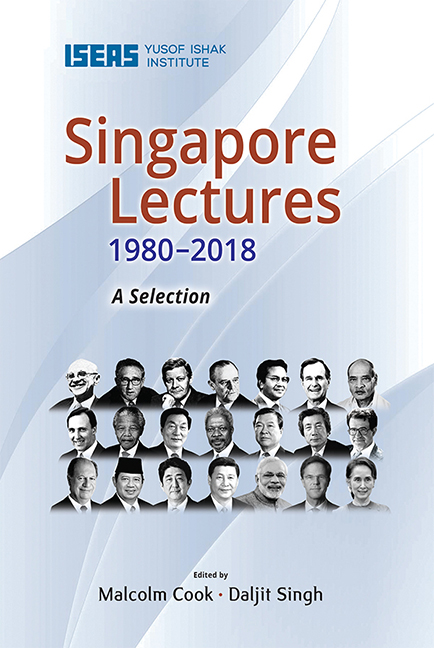Book contents
- Frontmatter
- Contents
- Introduction
- 1 The Invisible Hand in Economics and Politics
- 2 American Foreign Policy: A Global View
- 3 The Soviet Union: Challenges and Responses as Seen from the European Point of View
- 4 Trends in the International Financial System
- 5 Regionalism, Globalism and Spheres of Influence: ASEAN and the Challenge of Change into the 21st Century
- 6 US Policy in the Asia-Pacific Region: Meeting the Challenges of the Post-Cold War Era
- 7 India and the Asia-Pacific: Forging a New Relationship
- 8 Australia, Asia and the New Regionalism
- 9 South and Southern Africa into the Next Century
- 10 China and Asia in the New Century
- 11 Global Values: The United Nations and the Rule of Law in the 21st Century
- 12 Peace on the Korean Peninsula and East Asia
- 13 Japan and ASEAN in East Asia: A Sincere and Open Partnership
- 14 EU and Asia: Sharing Diversity in an Inter-regional Partnership
- 15 Global Challenges in the 21st Century: A View from Chile
- 16 Indonesia: The Challenge of Change
- 17 Japan and ASEAN, Always in Tandem: Towards a More Advantageous Win-Win Relationship through My “Three Arrows”
- 18 Forging a Strong Partnership to Enhance Prosperity of Asia
- 19 India’s Singapore Story
- 20 The Netherlands, Singapore, Our Regions, Our World: Connecting Our Common Future
- 21 Democratic Transition in Myanmar: Challenges and the Way Forward
- The Singapore Lecture Series
- The Editors
5 - Regionalism, Globalism and Spheres of Influence: ASEAN and the Challenge of Change into the 21st Century
Published online by Cambridge University Press: 09 October 2021
- Frontmatter
- Contents
- Introduction
- 1 The Invisible Hand in Economics and Politics
- 2 American Foreign Policy: A Global View
- 3 The Soviet Union: Challenges and Responses as Seen from the European Point of View
- 4 Trends in the International Financial System
- 5 Regionalism, Globalism and Spheres of Influence: ASEAN and the Challenge of Change into the 21st Century
- 6 US Policy in the Asia-Pacific Region: Meeting the Challenges of the Post-Cold War Era
- 7 India and the Asia-Pacific: Forging a New Relationship
- 8 Australia, Asia and the New Regionalism
- 9 South and Southern Africa into the Next Century
- 10 China and Asia in the New Century
- 11 Global Values: The United Nations and the Rule of Law in the 21st Century
- 12 Peace on the Korean Peninsula and East Asia
- 13 Japan and ASEAN in East Asia: A Sincere and Open Partnership
- 14 EU and Asia: Sharing Diversity in an Inter-regional Partnership
- 15 Global Challenges in the 21st Century: A View from Chile
- 16 Indonesia: The Challenge of Change
- 17 Japan and ASEAN, Always in Tandem: Towards a More Advantageous Win-Win Relationship through My “Three Arrows”
- 18 Forging a Strong Partnership to Enhance Prosperity of Asia
- 19 India’s Singapore Story
- 20 The Netherlands, Singapore, Our Regions, Our World: Connecting Our Common Future
- 21 Democratic Transition in Myanmar: Challenges and the Way Forward
- The Singapore Lecture Series
- The Editors
Summary
On 14 December 1988, Prime Minister of Malaysia Mahathir Bin Mohamad gave the 9th Singapore Lecture after being welcomed by Singapore's first foreign minister S. Rajaratnam. Prime Minister Mahathir was the first Asian leader to give a Singapore Lecture and the second sitting political leader to give a Singapore Lecture following Prime Minister Bob Hawke of Australia in 1987. Prime Minister Mahathir's lecture stands out for its broad and ambitious vision. The lecture weaves together the emergence of a pragmatic post-Cold War global era, the rise of China and the need for closer ASEAN integration and cooperation in this emerging global order. The lecture serves as a useful source of reflection for current analysis of these very same issues.
Mr Rajaratnam, Honourable Prime Minister, Excellencies, Ladies and Gentlemen.
Before I speak I would like to say thank you to Mr Rajaratnam for his kind words. I am afraid he has raised too many expectations from my talk. I am going to be very conservative tonight and I am not going to be nasty to anyone. So, it would be a different person from the person who was born on 20 December 1925 who will be speaking before you tonight. So I apologize for the disappointment I am about to cause.
I would like to thank the Institute of Southeast Asian Studies for inviting me to deliver this Singapore Lecture, the ninth in your series. It is indeed a great honour for someone who is not an economist and who is not a retired statesman to be invited to speak at one of the most celebrated events of the Institute.
The subject of this Singapore Lecture is related to the future. My fear is that economists and politicians, retired or otherwise, are about as good at foretelling the future as those who rely on the stars and the tea leaves. Practising economists have the aid of the most sophisticated models and the most sophisticated and complex theories. The members of this profession have the advantage of being able to rely on the staple of their trade: the two hands—on the one hand, this, on the other hand, that.
- Type
- Chapter
- Information
- Singapore Lectures 1980-2018 , pp. 76 - 96Publisher: ISEAS–Yusof Ishak InstitutePrint publication year: 2020

